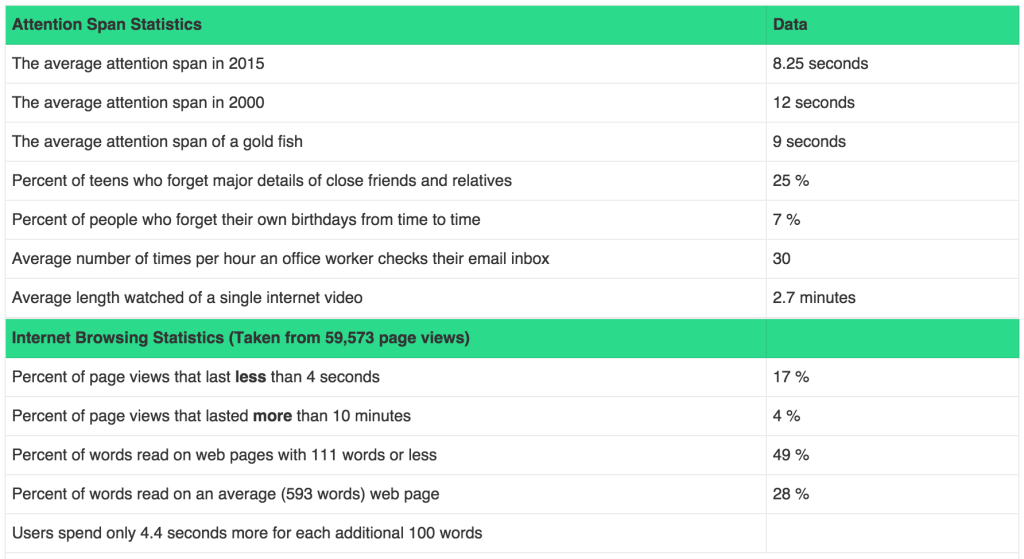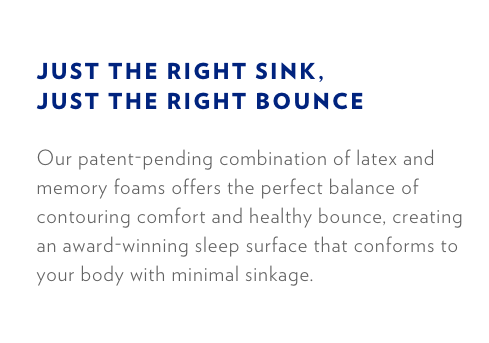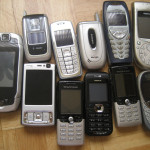The written word (or at least typewritten word) is an often overlooked part of an ecommerce merchant’s brand. While awesome product photography and website design work visual wonders for a brand, product descriptions are another essential piece. And the best way to create stellar copy are through these three words: conciseness, relevancy, and tone.
Length Isn’t Everything
Here’s why those words are so crucial. Being humans, we’re at the top of the food chain, but it comes at a cost, and it’s apparently our attention spans. Goldfish have us beat in that department. Just look at these stats from Statistic Brain Research Institute:
Given those stats, thank you so much for making it this far. Even if a read takes less than 10 minutes, bounce rates tend to fluctuate between 40% – 70% – a huge void. That means conciseness and relevancy are absolute priorities when creating any type of copy, especially that of your product related pages, like landing pages and product descriptions.
Two Words for Using Words
The good news is that customers stick around on your website to get a good look at your products, so they should be inclined to stay longer unless your price points shock them in smacking that back button. That said, conciseness and relevancy are important to use if you want to get the customer’s attention quickly and effectively.
Relevancy – No site visitor is interested in reading copy that isn’t relevant to them. It’s that simple. When a potential customer scans the product description, they’re looking for relevant information on the item, whether it’s size, fabric, color, materials, etc. Too much irrelevant information or lack thereof are sure to lead to either a bounced visit or an unsatisfied customer post-purchase.
Conciseness – Let’s be clear, conciseness is more about clarity than it is about shorter word count, but a happy balance between the two is preferable. Copy should aim to get the point across clearly and efficiently, covering product specifics while avoiding a bunch of mumbo jumbo filler. Walls of text tend to scare away customers (especially considering attention spans are as low as they’ve ever been) and a lack of information is sure to do the exact same thing.
Using Just the Right Words
So what should you be writing about in these product descriptions? Anything you feel the customer needs to know:
- Each and every benefit the product provides, i.e. why the customer should buy
- What exactly the customer is receiving on purchase, i.e. components
- Product qualities, i.e. how it’s made, what it’s composed of
- How it relates to your brand, i.e. any history around the product, whether it’s a best-seller
- Product warnings, i.e. when not to use or buy the product, areas where the product is usable
It’s easy to list out what needs to be highlighted. Using the right words, however, is a bit of a different story.
Toning Your Words
Although conciseness and relevancy are important, being extremely to-the-point doesn’t mean your copy should be dry and tasteless. That’s where your tone comes in.
Similar to how a brand logo illustrates personality in a visual way, a brand’s tone expresses that personality through words. And just as you would incorporate it into your site design, it’s important to sprinkle your brand throughout your copy as well. Tone gives flavor to words that are otherwise boring and emotionless.
A good example of this comes from an online mattress company called Casper. Throughout the entire experience navigating the site, there’s this feeling of comfort and quality – values any mattress company would probably strive for. The following is part of a product description that does just that. Check out how these words breathe:
Another different example comes from a company called Shakoolie. “Shower beers” are a trend – a perfect niche market as well – that they’ve capitalized on (if you haven’t ever experienced a shower beer you should give it a shot). Their product descriptions tend to be more descriptive and humorous. Check out this one for their “Muricans For Shower Beers” Shakoolie:
At first glance, this description might be the opposite of what we’ve said; it seems pretty wordy. But it has all the information that a customer needs to know, plus entertaining elements of their brand. It’s also lengthier because it highlights specifics on what exactly the product is, where it works, and how to be safe.
A Final Word
And if there’s any doubt in your mind that conciseness, tone, and relevancy are they keys to copywriting success, I’ll leave you with one reason to believe. In acronym form, those words spell CTR. What’s CTR stand for? Click through rate. What is copywriting aiming to do? Get customer clicking on products to buy. It’s no coincidence – take my word for it!
Image: Brendan DeBrincat, Flickr






